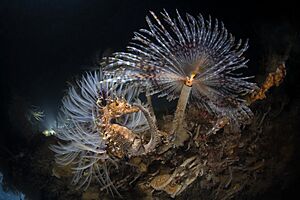Peacock worm facts for kids
Quick facts for kids Peacock worm |
|
|---|---|
 |
|
| Peacock worms (Sabella pavonina) with a short-snouted seahorse in Porto Cesareo, Italy. | |
| Scientific classification | |
| Genus: |
Sabella
|
| Species: |
pavonina
|
The peacock worm, scientifically known as Sabella pavonina, is a fascinating sea creature that looks more like a beautiful, feathery flower than a worm. It is a type of bristle worm that lives in the ocean.
You can find these worms along the coasts of Western Europe and in the Mediterranean Sea. They prefer shallow waters where the seabed is made of mud, sand, or gravel. Sometimes, they even make their homes on rocks or old shipwrecks!
What is a Peacock Worm?
The peacock worm is an animal that spends its life anchored to the seafloor inside a protective tube. What we usually see is its colorful crown, which it uses to breathe and catch food. It gets its name from this crown, which can look like the fancy tail feathers of a peacock.
Appearance and Body
The peacock worm has a very distinct look. Its body is hidden inside its tube, but the part we see is quite amazing.
- Body: The worm's body is long and thin, growing between 10 and 25 centimeters. It is divided into hundreds of tiny sections, or segments. The body is usually a grey-green color.
- Crown: The most stunning feature is its head. It has two beautiful, fan-like crowns made of feathery tentacles called radioles. These crowns can be brown, red, or purple and often have darker stripes.
Home and Habitat
The peacock worm is a master builder, creating its own safe and cozy home on the ocean floor.
Building a Tube Home
The worm lives inside a long, tough tube that it builds itself. It makes this tube by sticking together fine mud or sand particles using a special sticky mucus it produces. The tube stands straight up from the seabed, with the bottom end attached to a stone or shell for stability. This tube protects the worm's soft body from predators and the environment. As the worm grows, it adds more material to the top of its tube, making it longer.
Where Does it Live?
Peacock worms are found in shallow coastal waters. They need a soft seabed of mud or sand to anchor their tubes. They are common in areas with gentle water currents, which bring them the tiny food particles they need to survive.
How Does It Eat?
The peacock worm is a filter feeder. This means it catches tiny bits of food that float by in the water. When it feels safe and is covered by water, the worm pokes its feathery crown out of the top of its tube.
The feathers on the crown have tiny hairs called cilia. These hairs beat back and forth, creating a small current that pulls water through the crown. Tiny food particles get trapped in the feathers and are guided down to the worm's mouth at the center.
If a particle is too big to eat, the worm doesn't just waste it. It uses the larger bits of sand or shell to build and repair its tube!
Staying Safe and Healing
Life on the seafloor can be dangerous, but the peacock worm has some clever ways to protect itself.
Its crown is extremely sensitive to changes in light and pressure. If a fish swims by or a shadow passes over it, the worm will instantly pull its entire crown back into its tube in the blink of an eye. This quick reflex helps it hide from hungry fish that like to nibble on its feathers.
Even if a fish manages to bite off the top of the tube and part of the worm, the peacock worm has an incredible ability to heal. It can regenerate, or regrow, the lost parts of its body, including its beautiful crown.


